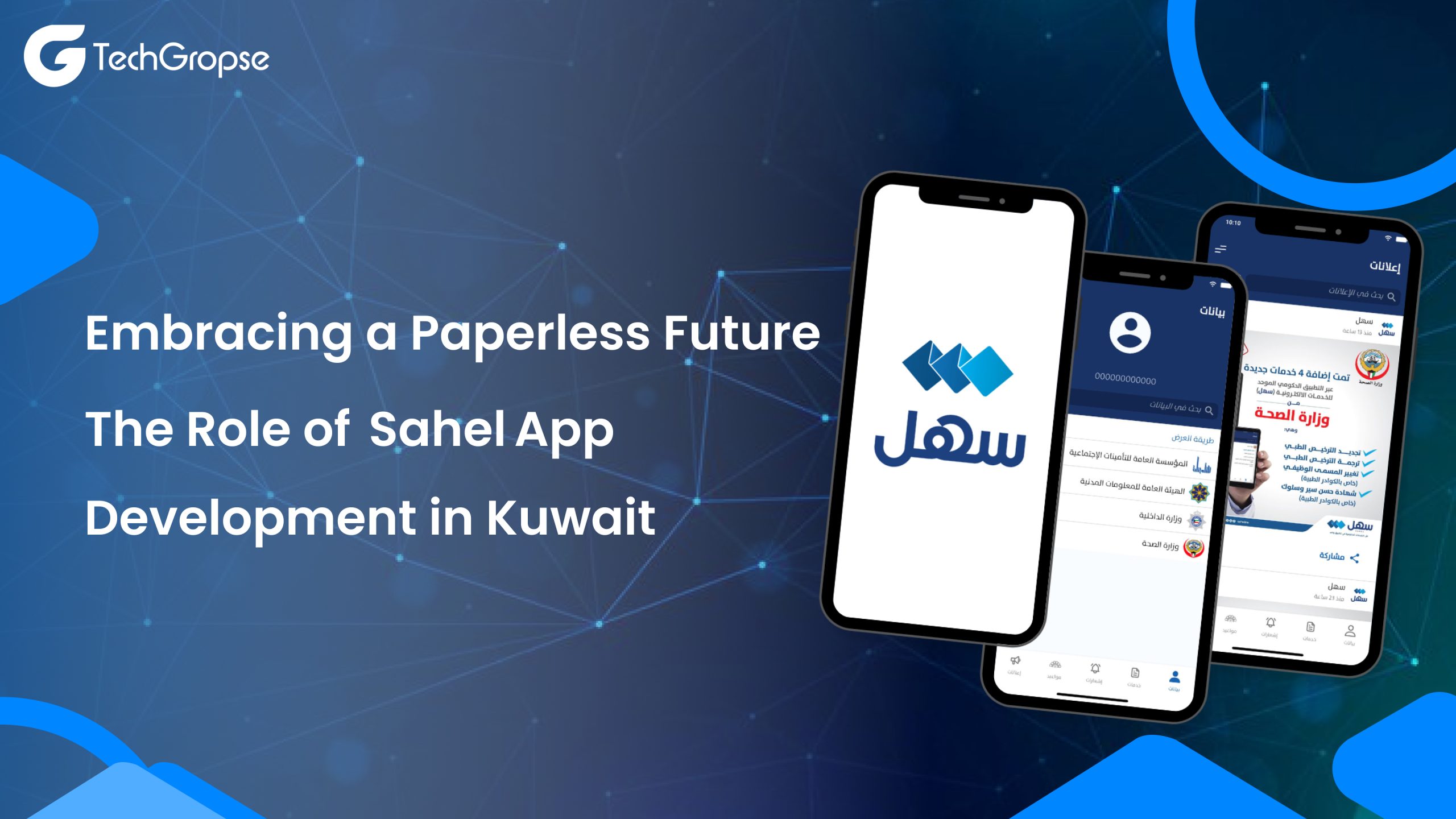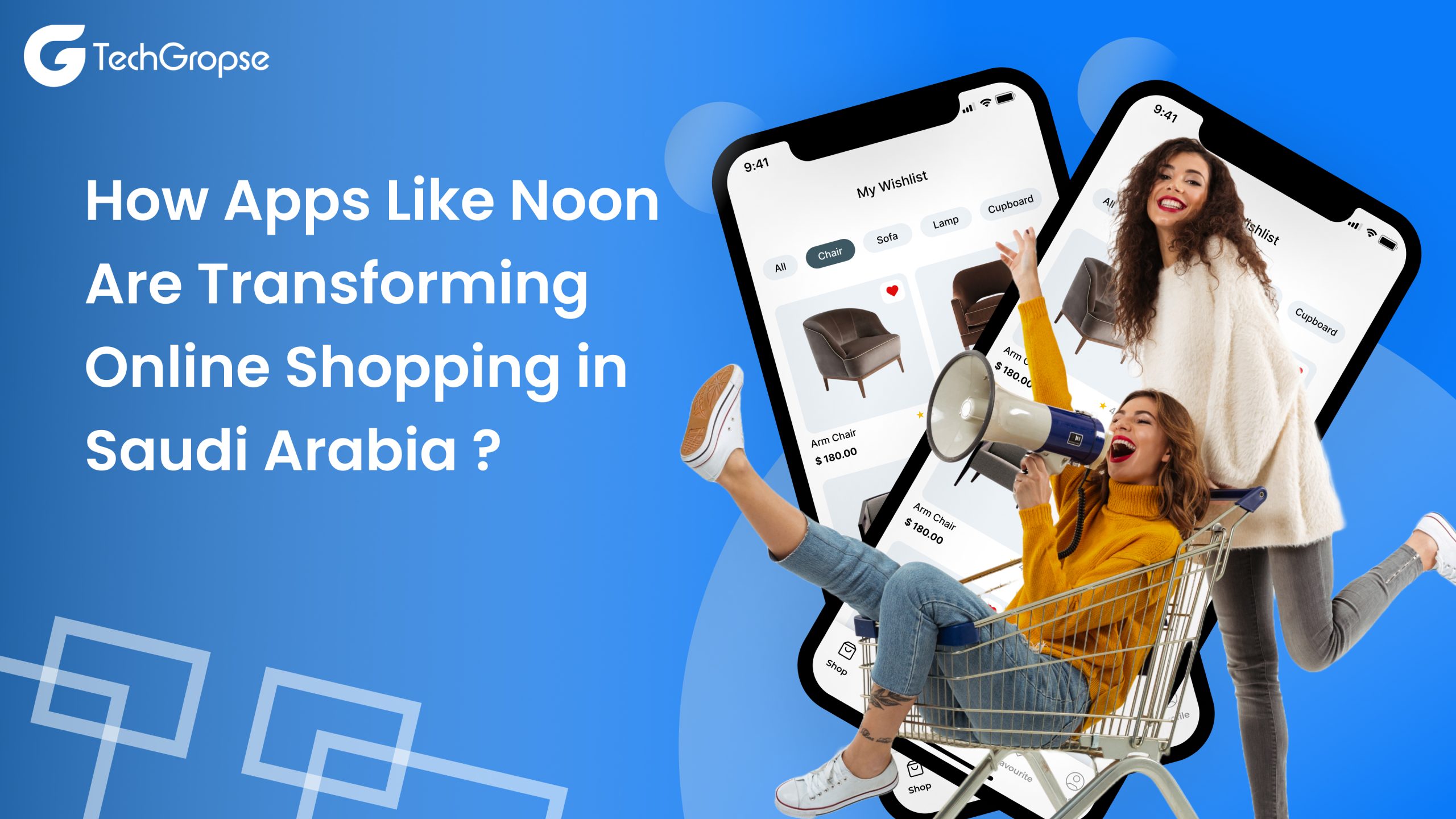Minimum Viable Product or MVP is a technique where presented in front of the target audience with its basic features. We all want to develop a product which has demand in the market. There are so many products introduced in the market which does not have any demand and ultimately the market collapses. So here we are talking about generating a product that can fulfill the gap between supply and demand. The team of product development gathered feedback from the market and added those desired points into the final product. This is the full minimum viable product definition.
The Minimum viable product is designed in such a way where it is not a final product but a dummy of it. Minimum viable product examples are laptop, smartphone, car, TV, or washing machine. It can be anything. Firstly, it is launched in the market and then asked users for recommendations and feedback to improve the product further. This enhances the excitement in users. The SWOT analysis technique is used to maintain the demand for the product. So this is the MVP meaning in business.
There are three features of a product that it would have several features that make the user buy the product. The other one is it has some feedback options. The feedback options help the companies to do the desired changes. And the last one is that it would have enough benefits for consumers. The whole scenario of Minimum viable product is to make your product usable and demanding through various improvements.
Another minimum viable product example is an eCommerce website development company where it just publishes its eCommerce app in the market and observes how users respond to it. Minimum viable Product helps MVP product management team to study the market and then have some changes in your product as per demand. It is less costly and more solution-based. Later, we will talk about Minimum viable product Goals, Benefits, Types, Development, and examples. Let’s begin!
Why Do You Need A Minimum Viable Product?
The main purpose of MVP is to eliminate the cost and resources from being wasted. MVP contains features that solve the critical issues of the users. Except this, everything is being added after the product preview in the market. Businesses learn the capability of the market to purchase your product through a Minimum viable product. Your product development process could be faster if you want to test your product and study the market at a fast rate. Basically, the minimum viable product focuses on eight purposes :
- It testes the viability of product at low costs
- Through MVP, few amounts are invested in product development
- MVP helps to do quick delivery of values which resolves the problems of some audiences.
- MVP helps you to save resources and money which will not be going to help you to succeed.
- It helps you to grow your user base before the actual product.
- It helps you to validate product ideas with real life examples.
- Through MVP, you don’t need to utilise time in the market for new features.
- You test your product market fit before a full fledged product.
Can You Go Without Building a Minimum Viable Product?
Yes
The MVP is a Lil risky but it is a shorter way of production. You do not expect to save time for the development process. Once you have enough user base and brand awareness then you can reduce your development time and handle user feedback. If your motive is to raise funds then you are not selling product expectations but the actual result. There is a major risk that the investors will not be impressed enough in case your MVP is faint.
No
Prototype and Concept are not enough to validate the market. MVP for start-ups determines the several aids of the product like market validation, early user acquisition, and resources optimization. But the question is will your MVP product can generate revenue for you and value for others. MVP is a single method to obtain the opinions of external users at early stages. It helps you to reduce tons of money and resources into something nobody wants to learn.
Aids of Minimum Viable Product
MVP can help you to enhance user engagement and saves you from losses. Here we have explained some minimum viable product benefits :
-
Verify Market Demand
MVP helps you to preview your product in front of users before the final product. Through this, you study the reaction of the market after seeing your product and you find the targeted audience. This is how you can verify the market demand for your product.
-
Testing Business Concept
You can test the whole concept of a minimum viable project. Releasing your app with several features would harm your business because the target audience would not adjust to it. With a few features, you can enhance the functionality of those features.
-
Cost Efficiency
As through the MVP development process, we just make a dummy of the product. It helps us to invest less money and get solutions to optimize the cost. It is more solution-based and less costly.
-
Wining Stakeholders
If your MVP product entices the investors to spend in your product then it also helps companies to depend on outside investments. Some companies like Techgropse help a number of start-ups to gather funds and it is a great way to work.
Types of Minimum Viable Product
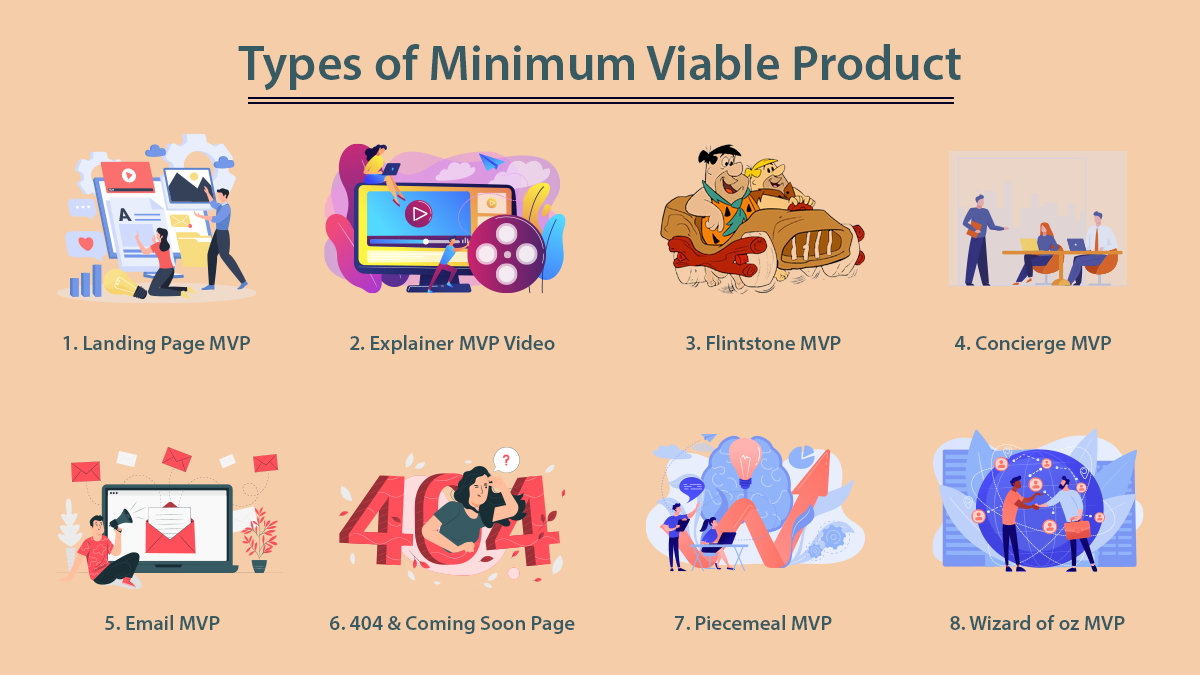
You may invest lots of money and invest still there are possibilities that users would not use it. So here we will talk about 8 different types of MVP that help you to enhance the demand in the market. It will help you to optimize your cost and resources in a proper manner. These are safe minimum viable product types. Let’s begin!
-
Landing Page MVP
If you want to know the total target audience so you can build a landing where interested users will register. This will help you to run campaigns to similar audiences as well.
-
Explainer MVP Video
You can also use an explainer video to understand the features of your audience. Through dropbox solutions, the organization conveys the real value of that MVP product.
-
Flintstone MVP
You can use low-cost models for your MVP product. You can create an illusion where a complete product functions efficiently and delivers solutions.
-
Concierge MVP
Through concierge MVP, you deliver non-scalable and inefficient development rather than developing a final product. You can deliver products based on manual work.
-
Email MVP
Through email MVP, you require an email list and an email client. You can pitch users about your new product and analyze how the users react to it. Smaller organizations can use this technique as it is cheap, fast, targeted and limited damage.
-
404 & Coming Soon Page
The 404 page states that the page is under development. It tells the users that something exciting is developing and coming soon so you can ask users to subscribe for future notifications.
-
Piecemeal MVP
Through piecemeal MVP, you do not make a new MVP product but use already existing software. You join its pieces, add some functionalities and then you test the basic version of it. You can add some common functionalities for MVP testing.
-
Wizard of oz MVP
The name of this MVP type is taken from the title of the movie. Where there is a wizard which becomes an old white guy. So this experiment is also similar to this as you just have to make an MVP product looking functional from the outside but in actuality, all the computer work and tasks handled by a human.
Key steps Required to Build A Successful Minimum Viable Product
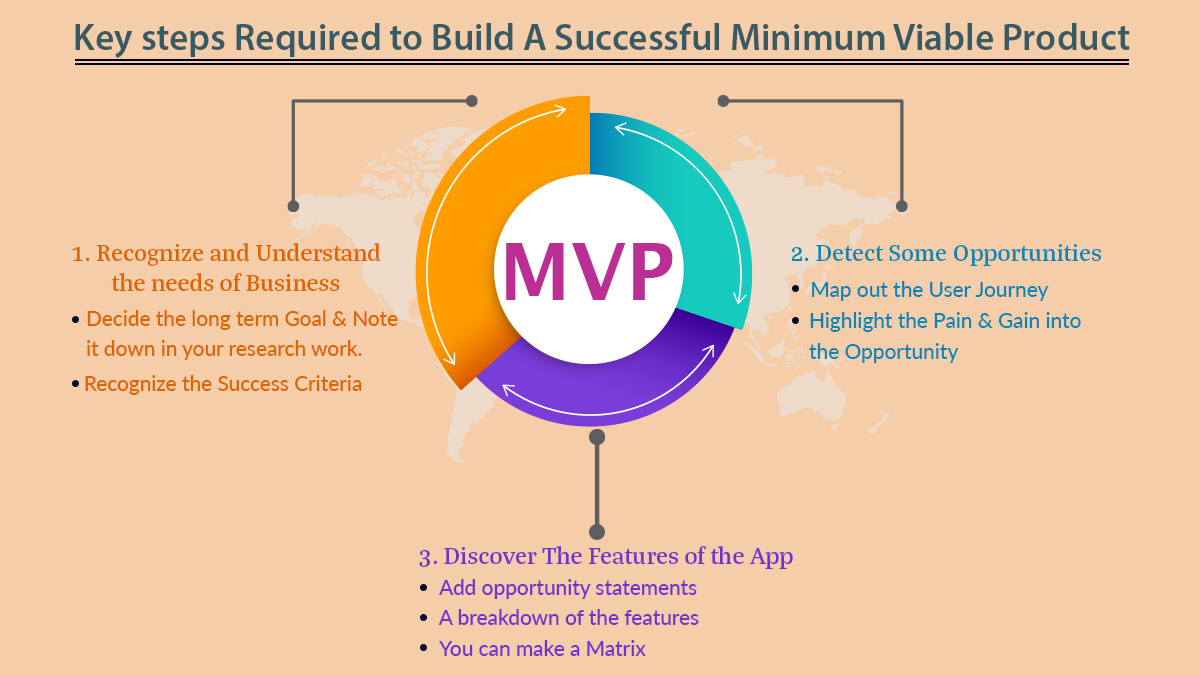
This a full guide of the minimum viable feature development process. There are basically 3 steps to follow:
1. Recognize and Understand the needs of Business
First, you have to recognize the market carefully and analyze the market situation. You can learn the customer’s needs and demands while carefully studying the market. This helps you to
- Decide the long term Goal & Note it down in your research work.
You have to ask questions like why are you doing this project and what are the goals you are going to achieve with the help of this project. You have to find problems where your project will be solving it and filling the gap.
- Recognize the Success Criteria
whether your project will be successful or not. What would be the metric that tells you whether you are successful or not? You have to take some KPI’s and measure them and conclude the ultimate outcome of the project.
2. Detect Some Opportunities
Through analyzing the market, you can find the client’s problems. Convert these problems into opportunities. It helps you to analyze the gap in the market and how your product fulfills its gap. This step will help you to
- Map out the User Journey
As you have to research customers from its awareness, consideration, and decision stage. You will get several types of consumers so you have to know which stage of users you are handling.
- Design a Pain and Gain map
for every activity where users will be experiencing all kinds of pain and gain through your product. So you have to note the actions of users during user journey, pain point actions, and gain point actions. You have to make a list where there is an achievement for every pain point.
- Highlight the Pain & Gain into the Opportunity
where you can write statements like how we can make it easier where you are defining pains and gains in the earlier steps.
3. Discover The Features of the App
This stage will help you to find out which features should be added to your MVP product. Through this, you are adding the features which solve the problems of the customer. This is the most critical stage of the MVP development process so you have to be careful in the last stage. Through the last stage, it will help you to
- Add opportunity statements
To conclude your features where you clearly mention the features which are going to resolve the issues of clients.
- A breakdown of the features
Features that are added in product Roadmap. The user roadmap is full of pain and gain points so this breakdown of features will help users into their roadmap.
- You can make a Matrix
A matrix that helps you to prioritize features through this you can highlight existing features and what features will be added after the MVP development process.
Key Metrics to Measure Your MVP Success
Feedback
Customer feedback is an essential metric to measure the success of a whole project. This metric is more actionable when your product is at the MVP stage. You can learn how things are going on by interviewing your customers. You can make a list of problems to be solved and expectations to be met for the evolution of your product.
Net promoter Score
NPS is a survey based metric. Here you ask customers directly how they feel about your product. Here you ask how much you will give from 0 to 10. There are three categories you put users under are passive, detractors, and promoters. If your NPS obtain more than zero then you have better chances of success.
Activations
Activation states how good the user’s first experience was. If the number of registrations were high then your product is doing good. Your new users bring not only revenues but new stories to improve your product. If you do not get new users then you have to find out ways to get new users. Your poor UI/UX can be a major reason.
MRR
You have to check the total amount of money your product generates. MRR or monthly recurring revenue includes money based data which is a core financial metric for each SaaS product. The metrics shows the direct income, possible upgrades and downgrades, reactivations, churns, discounts, and other money related activities.
CAC
After MRR, another financial metric you can measure is customer acquisition cost or CAC. The metric helps us to determine how much money we have to invest to get a single customer. This metric tells us how scalable and profitable our product is. If suppose you invest more money to get a customer and receive less money as profit then our product is not profitable.
ARPU
The ARPU stands for average revenue per user. This metric is generally used by organizations to measure their growth. This metric helps you to know how much revenue you can expect from a single user. You can divide total revenue by total number of users to calculate the metric.
Some Examples of Minimum Viable Product
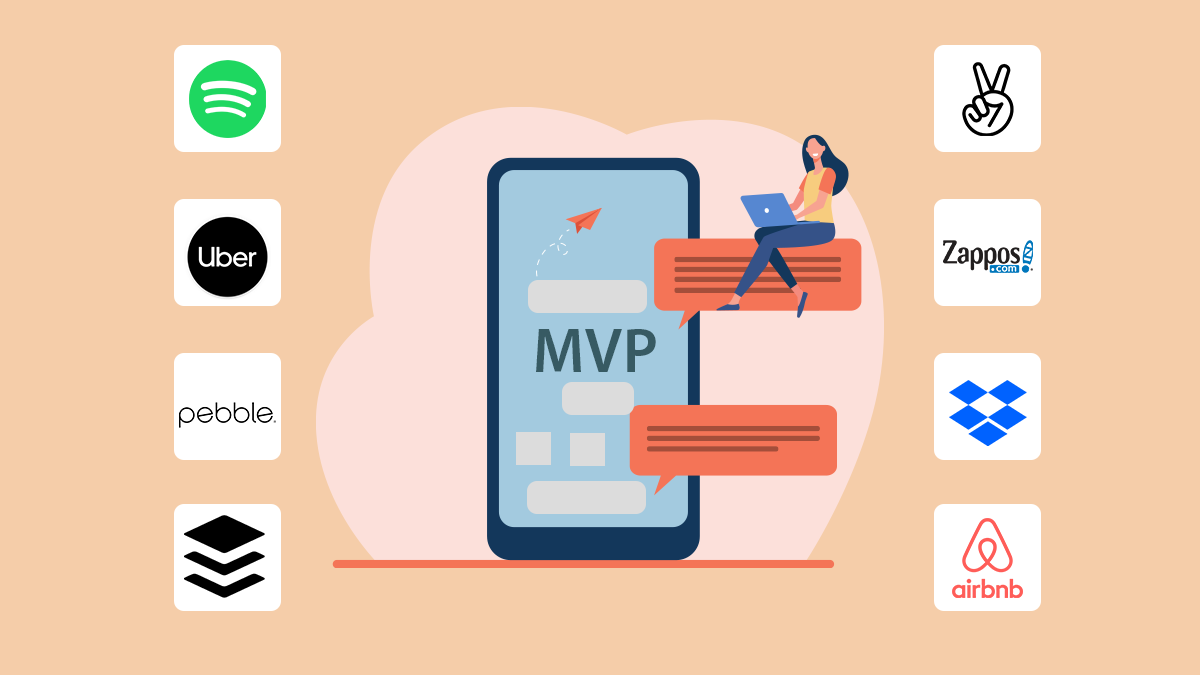
Some organizations used MVP projects and became successful in their journey. Here we have discussed some examples :
-
Spotify
Initially Spotify did not receive recognition in the market as there were several music apps in the year 2006. They realized that other music apps charge fees to taste music. So they provided a desktop app and integrated music streaming feature.
-
Uber
Some people were disappointed by high fare prices in cities like San francisco. They developed an uber app which can work on iPhones which were only available in the city. This MVP product helped them to study the market through the uber app.
-
Pebble
Pebble used e-paper in the predecessor of smart watches. He produced the demo of an MVP product in the market. He also asked for investment and raised $10,200,000. Later, the project was acquired by Fitbit.
-
Buffer
The founder introduced a web page with various features and subscriptions instead of a product development. The webpage shows suggestions to follow the development process which helped the founder to understand the customer base.
-
Angelist
The founders of angelist did not make complex websites but maintained their simple angelist. They also relied on old emails and few connections for investment opportunities. They still achieved success on a small scale.
-
Zappos
The founder tried MVP in such a manner that initially he went to a shop and clicked the pictures of some shoes. He decided that if people will purchase it online then he will purchase the shoes from the shop. This strategy made him a billionaire.
-
DropBox
The DropBox used a 3-min video which explained the values conveyed by its product. He understood that it would take lots of investment and time to make a prototype. So he simply made a video which described how DropBox works.
-
Airbnb
Two guys did not have enough money to start a start-up. So they decided to rent their upper floor through communication. They created a landing page and uploaded the pictures of their apartment. Thus, they developed a platform Airbnb which provides a short-term renting place.
Minimum Viable Product- The Bottom Line
After reading this page, you have what does MVP means? We have explained the minimum viable product definition through various examples. Now you have understood that before developing a product, MVP product is necessary to understand the requirements of the market. This passage clearly states that lots of investment and time cannot make your product successful until and unless it has demand in the market. While concluding, we advised to study the market and use testing, prototyping, and preview of the product before the final product. We hope you find the article understanding and informative.

Hello All,
Aman Mishra has years of experience in the IT industry. His passion for helping people in all aspects of mobile app development. Therefore, He write several blogs that help the readers to get the appropriate information about mobile app development trends, technology, and many other aspects.In addition to providing mobile app development services in USA, he also provides maintenance & support services for businesses of all sizes. He tried to solve all their readers’ queries and ensure that the given information would be helpful for them.








